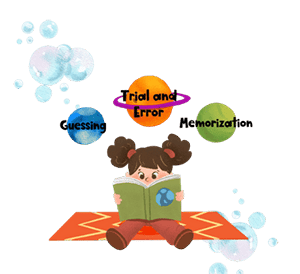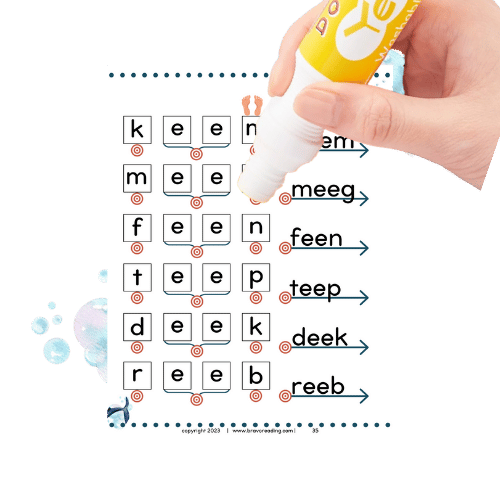Four Easy Ways To Stop Bad Reading Habits

If your child has dyslexia and struggles to read, bad reading habits can be to blame. You don’t know where to turn. Everyone tells you something different while your child gets further and further behind. Homework battles rage. Grades drop. And your child’s self-esteem gets lower and lower.

Well-meaning teachers might have told you to have your child read for twenty or thirty minutes every day. Or you might have purchased flash cards or phonics workbooks for extra practice. You might also have noticed that these methods aren’t working!
That’s because kids with dyslexia learn differently than other kids. To start with, their brains are wired differently. This doesn’t mean they aren’t smart. Quite the opposite! By definition, kids with dyslexia have normal to high intelligence.
Hands-On Learning Makes For Happy Reading!
In addition, kids with dyslexia are usually hands-on or tactile learners. That’s because most are weak in visual and auditory processing skills so they must rely on learning by “doing”. And if you checked out those reading methods above, they are all taught by “seeing” and “hearing”.

Learning by “seeing” or “hearing” is a death sentence for a child with dyslexia!
According to Wikipedia, dyslexia is a learning disability that affects either reading or writing. Usually, it’s defined as affecting both reading and spelling, as dysgraphia has come onto the scene as “writing dyslexia”.
If your child has dyslexia, then most likely, reading has been taught in this confusing way – a way your child definitely can’t ever comprehend, much less apply. To make matters worse, a high percentage of children with dyslexia are right-brain dominant. They learn best through movement, music, rhythm, creativity, and learning the “whole” instead of “bits and pieces”.
How Traditional Phonics Can Put Your Child In A Slump
Yet reading is typically taught through phonics, which is a “seeing” and “hearing” method of instruction. It’s also a left-brain dominant activity, which only serves to frustrate the right-brain dominant, dyslexic child.

These reading methods are like speaking a foreign language to your child. Unless a “translator” is called in, learning can’t happen. And it takes way too long for your child to learn a new reading “language” when there are reading and decoding methods available that meet your child’s needs, that speak the right “language” from the start. (Try the free Bravo! Punch Pack. It’s a great way to teach your child the right decoding “language” from the get-go.)
Because of these poor teaching methods that are used in most schools, your child most likely developed bad reading habits along the way. Just like eating too many sweets, engaging in large amounts of screen time, or grinding teeth, these bad habits can be stopped. It takes the right set of tools, a bit of effort, and consistency, but the outcome is amazing!
Making Bad Reading Habits Disappear Like Magic!
Three of these bad habits take the stage, and they are coined the Three Pillars of Poor Reading.

These bad decoding habits involve guessing at words, memorizing words, and using trial and error reading. If your child has dyslexia or struggles to read, then you’ve probably noticed them pop up at some time.
The first Pillar of Poor Reading is guessing at words, and it’s by far the most commonly seen in kids with dyslexia.
These kids are masters at guessing at words because they are weak in phonemic awareness, have poor decoding skills, and are stressed out, resorting to panic decisions instead of logically reasoning out how to decode new or unfamiliar words.
Lessons On Phonemes: They Matter More Than You’d Think!
Phonemic awareness is the ability to take heed of and manipulate phonemes, which are the smallest parts of spoken language. These tiny language units are combined with letters, other phonemes, prefixes, suffixes, and syllables to form words in our language.

Examples of phonemes are “ip”, “ex”, “ug”, “ap”, and “ob”. There are forty-four phonemes in the English language. As mentioned above, by adding other language components to these basic units of sound, words are constructed.
Knowing how to recognize and manipulate not only phonemes but the added language components attached to them to form words is called phonemic awareness. Kids with dyslexia typically struggle with phonemic awareness and because of this, they resort to guessing at words.
A Bad Reading Habit You Never Want Your Child To Form
When asked to read a new or unfamiliar word, your child might start out strong, perhaps decoding a few letters. Then, panic sets in. Since your child probably doesn’t have a proper set of decoding skills to sound out the word, desperation takes over; the word is read incorrectly.

Sometimes, the word is guessed correctly. Usually, it’s wrong.
Even if your child guesses the word correctly, decoding strategies and phonemic awareness are still weak, and your child will continue to guess at new or unfamiliar words.
The second Pillar of Poor Reading is memorizing words. On the surface, this appears to be a viable strategy. But memorizing words instead of decoding is far too labor intensive because there are over one million words in the English language! Although we only regularly use around thirty thousand words, that’s still a lot to wade through in an effort to find the right answer! This clunky process disrupts the flow of learning.
What Happens When A New Word Pops Up
It creates a pause, and this directly affects reading fluency and comprehension.
For example, your child might be reading along when a new or unfamiliar word appears. Your child goes into that vast memory bank of words, trying to pluck out the correct one.
It doesn’t come to mind.

Or…the wrong word pops up, and your child reads it incorrectly. Even worse, your child might get the answer correct, which causes the bad habit to dig its heels in even deeper.
Here’s the ugly truth. There isn’t much strategy involved in memorizing words when reading. To decode properly, your child must have a process, a strategy to use every time. Guessing and resorting to memorization are weak strageties…if they’re even strategies at all!
The Third Pillar of Poor Reading is trial and error reading. This is where your child randomly applies previously learned spelling and reading rules to the word being decoded, even though it’s not necessarily the right rule.
Random At Best: This Bad Reading Habit Hurts!
Trial and error reading is a step above the other two Pillars of Poor Reading, as at least there’s a bit more strategy involved.

The problem with this pillar is that that it’s random at best, and the rules aren’t consistently applied to decoding.
It’s the false positives of this pillar that will cause a heap of trouble for your child because the rule is rewarded for the wrong reasons.
Your child will then either randomly or consistently start applying the incorrect reading rule to all decoding experiences, and what a mess it all becomes!
It becomes a decoding free-for-all without firm rules and methods for sounding out words.
How To Stop Bad Reading Habits: It’s Not As Harp As You’d Think
Here’s the good news.
The Three Pillars of Poor Reading are just habits. Bad habits. Really, really bad habits.

But we know this about bad habits. They can be fixed in as little as twenty-one days! By using the right methodologies to help your child learn to decode words, then these bad habits can be broken. Replacing them with proper methods only makes it better.
Following are four easy ways to help your child break bad decoding habits:
- Have your child use a colored marker over print (text) and slide it across the word while reading out loud. If your child is reading in a book, you can put a clear plastic report cover over the page. Your child is to say the sounds of each letter while sliding the marker across that letter at the same time, blending them all together to form a word at the end.
- Use a recipe card or small square of cardboard and block off each letter as your child reads. Big print books help for this. Or, you can get an e-book reader and set it to large print. As your child reads, you (or your child) simply move the cardboard square along, revealing each letter one by one. This forces your child to sound out the word instead of guessing at words or reading the wrong word.
- Use nonsense words for practice. Start with three letter words with the consonant-vowel-consonant pattern (words like “yaz” or “nop” – just add a first consonant letter to the forty-four phonemic units that make up our language). You can write them on a white board, paper, or recipe cards – whatever’s handy. Have your child read them out loud one letter at a time. Once that’s easy, have your child blend them into the nonsense word.
- When listening to your child read, be sure to stop your child if a word is being read incorrectly. Gently correct your child and make sure that proper decoding (sounding out the word) is taking place. If your child is making a lot of errors, get an easier passage.
Ways You Can Make It Better!
Once your child stops engaging in the Three Pillars of Poor Reading, then reading skills take off. From there, your child must have a reading program designed specifically for kids with dyslexia. It must be based on large motor movement.

Remember how kids with dyslexia are hands-on learners, that they learn by “doing”, not “seeing” or “hearing”? They need their own “learning language”, and it starts with large motor movement.
Yes, decoding skills can be taught with movement. Did you also remembe that most kids with dyslexia are right-brain dominant learners and that movement is a right-brain dominant activity? Yes, that’s how these kids learn best!
Yet traditional reading programs continue to cater to the masses when we know that twenty percent of our school population has dyslexia.
This doesn’t even make sense!
So, be sure that large motor movement is part of your child’s decoding program.

Next, make sure your child’s reading program is based on phonemic units. Although kids with dyslexia are usually weak in phonemic awareness, if taught through movement, color, pictures, brain-based learning, and by using a multisensory approach (on steroids), your child can learn phonemic awareness.
That’s because this is a way of learning that makes sense to your child.
Not to you or your child’s teacher or to your mom or your neighbor.
It makes sense to your child.
And that’s who it should make sense to.

